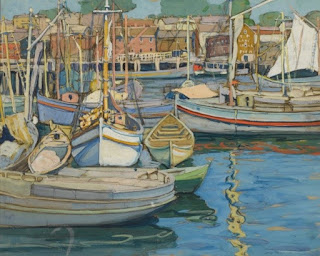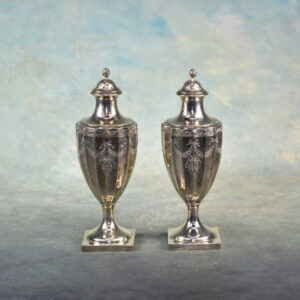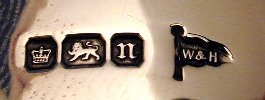When I think of mid-century modern glassware, I
remember wonderful dinners shared with my dear friend, Helaine, at a restaurant
named Cakes & Ale in Decatur, Georgia. We were working together doing appraisals as part of the Country Living Fair. A busy day was always
followed by a wonderful dinner. The restaurant had a colorful display of mid-century
glassware on shelves over their bar. If you ordered a cocktail, you never knew
which fanciful cocktail glass your drink would arrive in. Would it be a golden
Culver rocks glass or a sparkling Dorothy Thorpe silver overlay? A guaranteed
conversation starter.
Mid-century modern glassware can be found in vintage
and antique stores, garage and estate sales and flea markets. This article will
help you to know what to look for: possible markings, distinctive colors,
shapes and decorations that may reveal the maker of a piece.
Culver
Culver glassware can be found in vintage stores, flea
markets and on Etsy and One Kings Lane.
Prices range from $20 -$75 a glass
Important Note: Culver glassware cannot be put in the
dishwasher because of the gold overlay.
Blendo
Blendo glass was made by West Virginia Glass Company and Anchor Hocking Glass Corp. It was hugely popular in the 50s and 60s. This glassware lends a whimsical pop of color to entertaining. Blendo is characterized by a bright or pastel colored solid base that fades as it goes up the body of the glass ending in a gold rim. The gold rim is the signature of a Blendo piece. If you don’t see the gold rim, it is a knock off. Until 1968, pieces made by Anchor Hocking were marked with an anchor over H mark.
Blendo glassware can be found at Flea markets, thrift stores, garage sales, estate sales and on Etsy.
Prices range from $25 and up for individual pieces.
Important Note: These pieces cannot be washed in the dishwasher due to the gold rim.
Georges Briard
Georges Briard’s decorative housewares were all the rage in the 50s and 60s. In the beginning of his career, he purchased blank glassware from companies like Libbey and Anchor Hocking and embellished them with his designs. Later, he licensed his designs to companies that would produce the glassware with the design. His signed glassware was sold at Neiman Marcus, Bloomingdales and Bonwit Teller. His glassware is signed with his name in cursive
Briard glassware can be found at estate sales, flea markets, Etsy and at vintage stores.
Prices range from $150 and up.
Important Note: Most pieces will have to be hand washed.
Dorothy Thorpe
Dorothy Thorpe was known for her minimalist design. She settled in Glendale, California and produced tableware for high end department stores. Her work was created using blank glassware decorated with sandblasted designs of irises, roses and eucalyptus. She became most famous for her simple silver overlay and paint speckled glass pieces. Some of her glassware is signed with a large “T” and a small “D.” Most of it is unsigned.
Dorothy Thorpe glassware can be found at estate sales, flea markets, Etsy and at vintage stores.
Prices range from $100-$950.
Important Note: Most pieces will have to be hand washed.
Libbey
Libbey has made millions of glasses over the years: Collins glasses, tumblers, iced tea glasses, goblets, etc. Libbey glassware was in most American homes in the 50s, 60s and 70s. The glassware is whimsical. Decoration runs the gamut from sports themes, flowers, birds, dogs, stagecoaches, automobiles and travel. Vintage Libbey glassware is signed with cursive "L" in a circle. New Libbey glassware is signed with a cursive "L" without the circle.
Libbey glassware can be found at thrift stores, estate sales, flea markets, Etsy and at vintage stores.
Prices range from $10-$600.











.jpg)

.jpg)
.jpg)
















